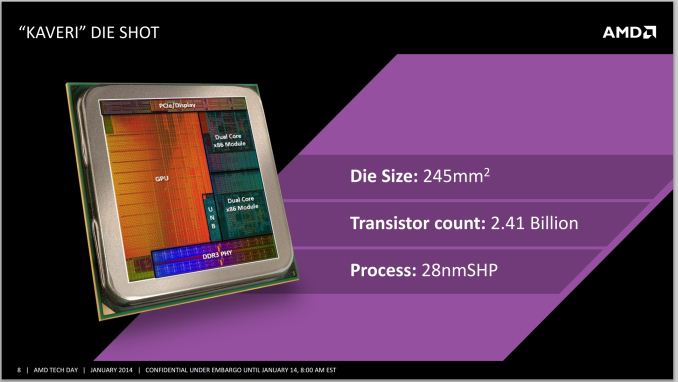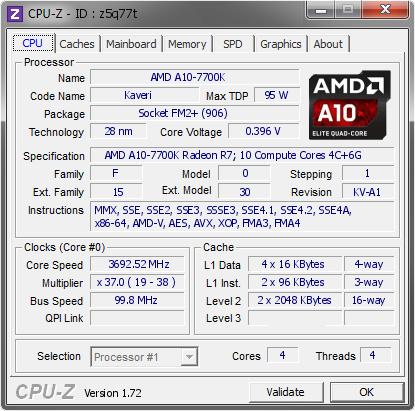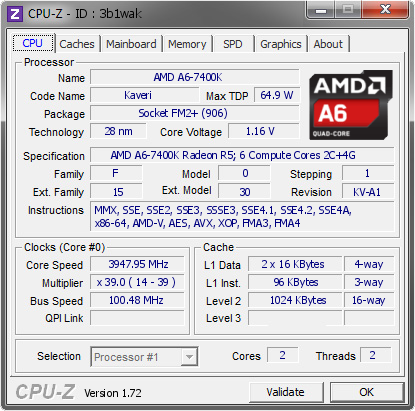The AMD A10-7700K and AMD A6-7400K CPU Mini-Review
by Ian Cutress on May 27, 2015 9:00 AM ESTAMD A10-7700K and AMD A6-7400K Conclusion
I started this mini-review stating that the question of the number of processors that both Intel and AMD produce all seem to differ by 100 MHz and $7, and that I had received questions as to why this is the case. Ultimately a lot of recommendations for computer components start to revolve around ‘Well for $10 more, you could get this’, and at some point you are considering something that costs $50 more. There has to be a point where you stop, especially if an IT department or system builder wants to go through and develop 200+ machines in a month.
Intel and AMD currently have different approaches to this. Intel likes to launch a big part of its stack all at once. Sometimes it will launch individual units outside this, or it will start a new line-up with one or two units then introduce the bulk later. With Haswell for example, on the socketed CPU space, we have 50 different CPUs varying in price, power, frequency, core count, threading and integrated graphics. Imagine the poor reviewer that has to test them all (insert here that I’d love to test them to get all the data, if I had time and could source them)!
AMD’s approach to Kaveri is to dribble rather than gush. Rather than overload the user base (both end-users and commercial) with a large haystack of parts, they launched two or three SKUs on day one, then one or two every 6-12 weeks since. This has some benefits, namely the improvement of the production process over time, the repeated opportunities to market new products and the opportunity to re-educate potential clients through the media. The downside of this strategy is one similar to starting with Swiss cheese and then filling in the holes – if a client wants a SKU with particular characteristics but the company does not have it, then they will go look for something else and take their money with them. It’s a method that acts as a double edged sword.
As AnandTech’s CPU editor, I get to play with a lot more SKUs than most. This means both the big shiny halo products, such as the 8-core goliaths, but also some of the higher volume dual core stuff which is more in line with a budget PC or mass PC build. With AMD’s strategy, as they have fewer processors overall, our coverage can be a little more complete than the others. AMD sampled us both the A10-7700K and the A6-7400K for this purpose, and we hope to work closely with them for future launches and get the best comparison list of their product stack.
Back to the SKUs tested for this mini-review, we can tell that the A10-7700K keeps up with the other A10 parts in our CPU testing, but as it has two fewer compute units in the integrated graphics it can lag behind a little and is more in line with the A8 processors in that regard, essentially making it more of a hybrid part. The A6-7400K fits into that budget CPU line at $64, and the results show this in both our CPU and GPU testing. The single module performs well enough in single threaded environments, but doesn’t have enough legs for the big tasks and can be swamped easily. Despite having two threads, the Bulldozer based design still has single-threaded like behavior in some tests. That being said, the graphics tests are a mixed bag. For titles that can use more threads, I can’t help but feel that it is a little held back, even at 256 SPs. For other titles, it performs on par with other processors almost double its price. Dual Graphics mode unfortunately was not possible with the A6, and it was also noticeable that some games (Shadows of Mordor in particular) took longer to load with only one module.
To say AMD’s APUs are like marmite (you either love them or hate them) is to gloss over a more complex issue. AMD’s design has its plus points and its negative points, a fact that AMD marketing knows when I speak to them. Nevertheless, they have to focus on the plus points, which include gaming at equivalent price points, DX12 support, OpenCL performance and moving forward with HSA. Using the right tool for the right job should now be considered a cliché, but it rings true when it comes to technology and more so than ever when innovative methods are continually being fashioned. Based on AMD’s Financial Analyst Day and their recent exposure into HBM (I highly suggest reading Ryan’s awesome writeup on it), I can safely say that I want to see an APU with HBM in the future. Despite the inevitability that AMD already know that people want one, I told them anyway. We will have to wait and see.














105 Comments
View All Comments
eRacer1 - Thursday, May 28, 2015 - link
"For those of us not red/green colorblind a review of the 7870k and 870k with their larger stock cpu coolers and improved IPC would have been very welcome."First review at CPU-World: http://www.cpu-world.com/news_2015/2015052601_AMD_...
"Both APUs have Radeon R7 graphics with 512 shaders, and the only difference is much higher GPU clock of the 7870K model. It runs at 867 MHz, which means that it could be up to 20% faster than the A10-7850K. Alas, we could not verify this assumption as the processor was not stable with the latest Catalyst beta drivers. It also did not run well enough in pure CPU applications, throttling down to the lowest power state after about 20 seconds of heavy load, then going back to one of the turbo power states, then throttling back, and so on...
This unexpected behavior prevented us from running any benchmarks as their results all turned out to be much lower than expected."
Looks like AMD sent out a PR statement about the launch. Did AMD marketing "forget" to send out samples for review?
Crunchy005 - Wednesday, May 27, 2015 - link
Ya one of the biggest differences between AMD, nvidia, and intel is AMD sucks at marketing. I mean look at Apple they aren't always the best for the price but they market really well and people don't notice, although you always get a quality computer even if you can get a more powerful windows for the same price.nils_ - Wednesday, May 27, 2015 - link
I have heard of the i5/i7 with only 2 cores (current Broadwell for example), but never heard of an i7 without HT?extide - Wednesday, May 27, 2015 - link
Those are mobile processors, and follow different rules. On the desktop, i7 means >= 4 cores + HT, while in the mobile line i7 means 4MB L3 cache / 2 cores. Mobile i3/i5/i7 all have HT.Desktop:
i3 - 2 cores, 2-3MB L3 x100 series = 2MB, x300 series = 3MB. No HT, No Turbo.
i5 - 4 cores, 6MB L3 Except R series, which has 4MB), No HT, Yes Turbo.
i7 - 4cores, 8MB L3 (Except R series, which has 6MB) Yes HT, Yes Turbo. (NOT INCLUDING HEDT PARTS)
Mobile:
i3 - Dual Core 3MB L3, Yes HT, No Turbo
i5 - Dual Core 3MB L3, Yes HT, Yes Turbo.
i7 - Dual Core 4MB L3 / Quad Core 6-8MB L3, Yes HT, Yes Turbo.
artk2219 - Wednesday, May 27, 2015 - link
Ah, but even on the desktop an I5 designation does not automatically mean that it has 4 cores, Intel still launches 2 core 4 thread "I5's", and they have since the launch of the original I5 (See the I5 680, 2390T, 3470T, 4570T, and 4570TE). Don't get me wrong, I absolutely hate the fact that they called this chip an "A10", but they're both guilty of this crap. Dont even get me started on most of the mobile "I7's".http://www.cpu-world.com/CPUs/Core_i5/TYPE-Core%20...
artk2219 - Wednesday, May 27, 2015 - link
Another note is that all I3's have HT, but not turbo. This is essentially what differentiates a mobile I5 from a mobile I3. Another note is that the pentium's are just I3's with no hyperthreading, and the Celeron is a lower clocked, lower cached, Pentium.extide - Monday, June 1, 2015 - link
Yeah, those T series don;t always follow the mold, but for the most part, there is indeed a logical way they do things.Although, they could have done better, for sure.
MrSpadge - Wednesday, May 27, 2015 - link
I agree, their Ax designations are moslty useless at best, or even misleading at worst.However, to be fair: Kaveri with 512 SPs or 384 SPs does not matter much in the real world. The bigger config is bandwidth starved anyway. This is not meant to be an excuse, just some soothing balm for "Essence_of_War" and other users.
Myrandex - Wednesday, May 27, 2015 - link
Oh what do you know my i5 I'm typing this on right now is dual core four threads. Yea AMD sucks for doing this, this CPU is the same as the highest end A8 with just 100MHz. increase on the base non turbo clock, what a waste. Intel is not guilt free either though they do crap like this as well especially in their mobile line.leexgx - Thursday, May 28, 2015 - link
almost all Mobile CPUs i5 are dual core cpus,but i agree i3 should be dual core with HT, i5 should be Quad core no HT and i7 should be Quad core with HT, but even so the i3 is faster then A10 typically